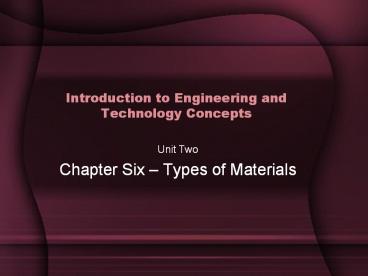Introduction to Engineering and Technology Concepts - PowerPoint PPT Presentation
1 / 14
Title:
Introduction to Engineering and Technology Concepts
Description:
Introduction to Engineering and Technology Concepts Unit Two Chapter Six Types of Materials Instructions for Success: Each chapter of every unit will begin with a ... – PowerPoint PPT presentation
Number of Views:360
Avg rating:3.0/5.0
Title: Introduction to Engineering and Technology Concepts
1
Introduction to Engineering and Technology
Concepts
- Unit Two
- Chapter Six Types of Materials
2
Instructions for Success
- Each chapter of every unit will begin with a
Mindjog. This is a warm up question that you
should answer in your workbook in the proper
chapter. - Please take notes as you move through the
presentations in the notebook that has been
provided. - Sections will come up in each presentation with
an assignment notice. Turn to the section
detailed on the slide in your workbook and
complete the assignment before proceeding. - Good luck!
3
Objective
- Students will classify materials according to
standards.
4
Mindjog!
- On your worksheet, please respond to the
following question - Recalling last chapters information on
materials, what do you think the difference
between natural, synthetic, and composite
materials are?
5
Material World
- Materials come in all shapes and sizes and they
are everywhere and each possesses specific
properties. - Materials can be classified as natural,
synthetic, or composite. - Natural materials occur naturally on the earth.
- Synthetic materials are human made, with the most
common being plastics. They are developed from
vegetable fibers (cellulose), natural gas, and
petroleum. - Composite materials are combinations of natural
and synthetic. For example, concrete (Wright,
2004).
6
Classification
- Materials that come from living organisms are
called organic materials. For example, wood,
cotton, and flax are products of plant fibers.
Wool and leather come from animals. Petroleum
and coal are products of decayed organic matter. - Inorganic materials do not come from living
things. For example, metals and ceramics. - Organic and inorganic is one way to classify
material (Wright, 2004).
7
Classification
- Some materials naturally occur on earth in a
specific amount. Another way to classify
material is by how fast those materials
regenerate. - Those that occur in a specific amount will not
regenerate. They are exhaustible. - Other materials have a life cycle and can be
regenerated they are genetic materials (Wright,
2004).
8
Classification
- Materials can also be classified by physical
state, in the form of solid, liquids, and gases. - Solid materials hold their size and shape. They
have an internal structure that causes them to be
rigid. (Wright, 2004). They can be divided up
into these categories metals, plastics
(polymeric), ceramics, and composites. - Liquids are visible fluid materials that will not
normally hold their size and shape. - Gases are materials that easily disperse and
expand to fill any space and have no physical
shape (Wright, 2004).
9
Properties
- All materials exhibit a specific set of
properties. They include - Physical properties characteristics due to
structure of the material. - Mechanical Properties the reaction of the
material to a force or load. - Chemical Properties the reaction of the
material to one or more chemicals. - Thermal Properties reaction to heating and
cooling. - Electrical/Magnetic Properties reaction to
electrical and magnetic forces. - Acoustical Properties reaction to sound waves.
- Optical Properties reaction to visible light
(Wright, 2004).
10
Information
- Knowing that materials can be categorized allows
us to create information. - As discussed, information is data that has been
sorted and categorized for human use. - Data is raw facts and figures collected by people
and machines. - There are three different types of information
- Scientific Information organized data about the
laws and natural phenomena in the universe. - Technological Information Organized data about
the design, production, operation, maintenance,
and service of human-made products and
structures. - Humanities information Organized data about the
values and actions of individuals and society
(Wright, 2004).
11
Assignment 1
- Please turn to the section in your workbook
entitled, Unit Two, Chapter Six Types of
Materials. - Complete the extension questions under the
Assignment 1 header before moving onto the
next section of slides.
12
BEFORE MOVING ON
- Did you complete the Assignment 1 Section
under the Unit Two, Chapter Six Types of
Materials section of your workbook? - If you have, please proceed to the next slide.
13
Unit Two Completed!
- Please close this presentation and launch the
file entitled, Unit 3, Chapter 1.
14
References
- Wright, R. (2004) Technology The
Goodheart-Willcox Company, Inc.































